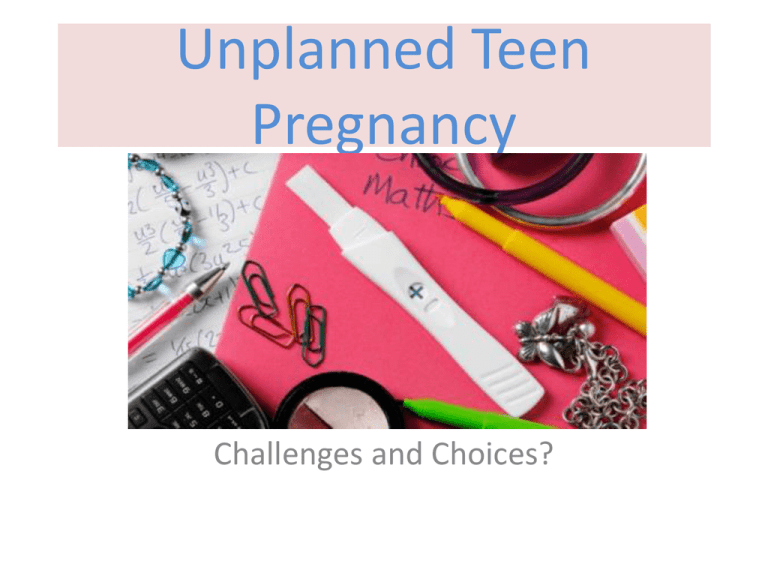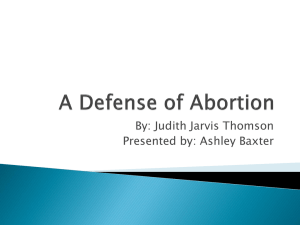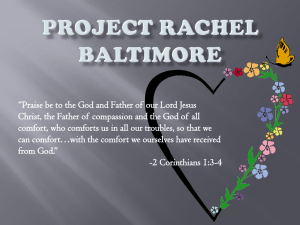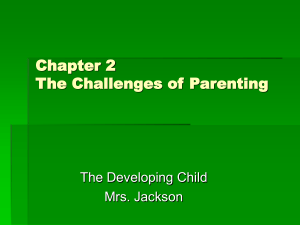
Unplanned Teen
Pregnancy
Challenges and Choices?
Teen Parenthood
Overview:
•
•
•
•
Telling Your Parents You Are
Pregnant.
Teen Parenthood.
Adoption
Abortion
Telling Your Parents…
Telling Your Parents You Are Pregnant
Read the article
(http://kidshealth.org/teen/your_mind/Parents/tell_p
arents.html )in class together.
If you are not in class that day, you need to write a
three paragraph summary of the article after reading
it.
After reading the article, you should reflect on the
challenges of telling your parents that you are
pregnant, or for guys, that you got someone
pregnant.
Telling Your Parents…
Assignment: Create a one page
dialogue between yourself and your
parents.
• Include the setting (when and where
you think you would tell them, if you
would tell your mom, your dad, or
both together, if you would ask
someone else to be there as well)
• Write what you would say, and what
you think your parents would say.
Telling Your Parents…
This should look like a play, not an essay.
For example:
Me: Mom and Dad, I need to talk to you.
Mom: Ok, sit down and tell me what is going on.
• The assignment is worth 20 points. You
can earn five extra points by sharing this
assignment with your parents.
• Have them sign your work to show they
read it with you.
• Don't pretend you are actually telling
them you are pregnant. This isn't a
reality assignment!
Teen Parenthood Stats
• The U.S. has the highest teen pregnancy rate
in the industrialized world – twice as high as in
England or Canada, and ten times higher as in
Switzerland.
• The U.S. teen pregnancy rate dropped every
year since 2006.
• About 1 in 3 women become pregnant at least
once before they're 20.
Teen Parenthood Stats
• A sexually active teen who does not use
contraceptives has a 90% chance of becoming
pregnant within a year.
• Only a third of teen mothers earn their high
school diploma. And only 1.5% have a college
degree by age 30.
• Girls born to teen mothers are more likely to be
teen mothers themselves.
• Boys born to teen moms are more likely to end
up in prison.
Teen Parenthood Stats
• 75% of girls and over half of boys report that girls who
have sex do so because their boyfriends want them to.
• 8 in 10 girls and 6 in 10 boys say they wish they had
waited until they were older to have sex.
• Most teens (6 in 10) and adults (3 in 4) believe that
teen boys often receive the message that they are
“expected to have sex.”
• Diapers are expensive, but it's nothing compared to the
$9 billion that teen pregnancy costs the United States
each year. This includes increased spending in child
welfare costs and public sector health care.
Teen Parenthood
1. List five things you are looking to
doing in the next few weeks.
2. List five things you are looking
forward to doing in the next few
months.
3. List five things you think you will
be doing a year from now.
Teen Parenthood
Would you be able to get it done?
Now cross off each thing that you
would not be able to do if you were
a teen parent.
What is left?!?
The Cost of Raising a Child
• Click here to read the rising cost of raising a
child article.
• Click here to calculate how much it might cost
to raise a child in your area.
• Why are teen pregnancy rates different in NYC
than in other areas?
Teen Parenthood
• Video and article about two teens struggling
as future teen parents.
Teen Parenthood
• Now after spending time looking at the
negative aspects and hard reality of teen
parenthood, work with a small group and list
the positive aspects of teen parenthood.
Teen Parenthood
Some positives might include:
– Younger people have more energy.
– Makes you grow up fast. (responsibility,
independence, time management, accountability)
– Will be closer in age to child, maybe have a better
relationship?
– Feeling that you did the right thing by keeping the
baby. (especially for those that are anti-abortion)
– Can still try to reach other goals after child grows
up. (education, career)
Myth #1 – Teen Parenting
• Myth: Parenting will be fun. I will get to play with my
child and dress him or her up in cute clothes.
• Fact: Although this statement about having a child can
be true, and parenting can be very satisfying, a baby
will not be able to show it's love and support to you for
some time. Babies are completely helpless and require
their parents to do everything for them to ensure their
survival. Parenting is a job that is 24 hours a day, 7 days
a week for the next 18 years of your life or longer. It is a
commitment that you will need to be prepared for.
Myth #2 – Teen Parenting
Myth: Having a baby is a way to receive unconditional love. My baby
will love me regardless of what I do and won't judge me. It will add
meaning and purpose to my life.
• Fact: Babies are very cute and it can be fun to dress them up, but
when it is your own child, it is not always fun. You must consider
the time and energy that you will need to give in order to meet the
needs of your child. Your freedom and moments of privacy can be
reduced to almost nothing after you give birth to your child and for
many years thereafter. Your child will go with you every where you
go. They will awake in the middle of the night to be fed, changed or
just because they are awake. If they get a cold, there will be more
doctor bills, time missed from work, and a loss of much needed
wages. This can be very challenging to any new mother or father
Myth #3 – Teen Parenting
• Myth: My family, friends, or partner will always be there to help
me out and pay for things.
• Fact: You are the only person who can guarantee your child's
health and well being. You cannot rely on other family or friends
who say they will help you because they may not always be there
when you need help. They are not in your shoes and although they
mean well by offering their help, they cannot make the decision for
you. Your family cannot guarantee they will be there at all times
when you need to run an errand, have to work, want to take a nap,
or want to go out with your friends. They also cannot be
responsible for paying for everything. If you have family support
that can help you with parenting, that is wonderful, but you cannot
rely on it.
Myth #4 – Teen Parenting
• Myth: If I choose to parent my child, I will not have to deal
with the feeling of sadness, loss and disappointment that I
would if I choose adoption or abortion.
• Fact: This may be true, but parenting will cause some of
these emotions to some degree. A woman may feel that
she has lost the opportunity to finish school, move to
another state, or go out with her friends. It could even
cause the loss of other relationships because you are too
busy or no fun anymore. Your friends may not want to be
around you much as time goes by because you have too
much responsibility. You may also feel sadness and
disappointment because you cannot give your child
everything you hoped for them to have.
Myth #5 – Teen Parenting
• Myth: It will save my relationship with my boyfriend
and we can get married and have a family together.
• Fact: Many unplanned pregnancies, especially among
young people, lead to stress and emotions that make it
hard for a couple to remain together. More than one
million babies were born to unmarried women in the
United States in 1998. One in six pregnancies
conceived by unwed couples result in marriage before
the baby is born (Options Magazine, 2003). Many
women are left to face the unplanned pregnancy alone
and it can be very scary.
The Adoption Option
Pros and cons of choosing to have
the baby and give the child to people
who want to be parents.
Facts and Figures
Are these statements
True or False?
• Only about 1,000 children are adopted each
year in the United States.
Facts and Figures
• Only about 1,000 children are adopted each
year in the United States. (False)
– Explanation: Actually, more than 80,000 children
are adopted in the United States each year.19
There are currently 1.5 million adopted children in
the United States, more than 2% of all children.
Facts and Figures
• Most families who adopt children do so
because they are infertile – that is, they
cannot get pregnant.
Facts and Figures
• Most families who adopt children do so
because they are infertile – that is, they
cannot get pregnant. (False)
– Explanation: Although many families do choose
adoption for this reason, over half of U.S. families
with adopted children also include birth or
stepchildren.
Facts and Figures
• Most adopted children were adopted when
they were babies.
Facts and Figures
• Most adopted children were adopted when they
were babies. (False)
– Explanation: Approximately 14,000 infants are
adopted each year because the birth mother voluntary
chooses to make an adoption plan for the baby. Most
children are actually adopted from foster care, and are
usually not babies when they are adopted.
• 17% of all adoptions involve birth mothers making an adoption plan
while still pregnant.
• 15% of children are adopted into the U.S. from another country
• 68% are adopted out of foster care.
Facts and Figures
• 4) If a woman chooses adoption for her baby,
she needs to get written permission from the
person she got pregnant with.
Facts and Figures
• If a woman chooses adoption for her baby, she needs to get
written permission from the person she got pregnant with.
(True)
– Explanation: The person a woman got pregnant with is the
biological father of the baby, and if he can be located, he must
give his permission to make an adoption plan.
– The biological father must sign a “consent to adoption,” stating
that he agrees with the choice to make an adoption plan.
Another option is for him to sign a “denial of paternity,” which
means that he does not believe he is the biological father, or he
does not want to be considered as the biological father. After he
signs a “denial of paternity” form he does not have any parental
rights or responsibilities for the child.
Facts and Figures
• If someone decides to plan for an adoption,
they can pick the family that adopts their
baby, if they want to.
Facts and Figures
• If someone decides to plan for an adoption, they
can pick the family that adopts their baby, if they
want to (True)
– Explanation: Almost all adoptions today work this way
– they are called “open adoptions.”
– In an open adoption, the birth mother or birth parents
are able to choose the family who will adopt the baby,
and they are able to have ongoing contact with the
baby after he or she is adopted. Some people send
letters and pictures, while other people have regular
in-person visits.
Facts and Figures
• It is legal to buy someone’s baby, as long as
everyone involved agrees to it.
Facts and Figures
• It is legal to buy someone’s baby, as long as
everyone involved agrees to it (False)
– Explanation: Although birth parents are sometimes
reimbursed for costs associated with the pregnancy,
adoptive parents do not ever “buy” the baby.
– Adoption is a legal process, and there are many laws
that govern it. Individuals who wish to adopt must
work with an adoption agency or an adoption lawyer.
Types of Adoption
Open Adoption vs. Closed Adoption
Open Adoption
• An open adoption is where the adoptive
parents and birth parents meet prior to the
adoption going through. Not only do they gain
contact prior to the adoption but they will
usually maintain contact throughout the life of
the child. This provides a way for the birth
parents to stay informed about their birth
child and maintain contact with the whole
family.
Closed Adoption
• A closed adoption: the parents, both adoptive
and birth ones, are in the dark as to who each
other is. The child who is adopted will also be
unaware of who the actual birth parents are
because the file is often sealed in a closed
adoption. Closed adoption often occurs with
international adoptions where adoptive
parents adopt their child from another
country.
Myths and Facts
• MYTH: A really caring mother would never give up her child
and you don't deserve to be a mother if you choose adoption.
• FACT: A mother who unselfishly creates an adoption plan for her
child is placing her child's best interest above her own. It is an
ultimate sacrifice for a mother to choose life for her child and
realize what is best for her child. Adoption is a caring and
responsible process that is as natural and loving as parenting.
Myths and Facts
• MYTH: My child will hate me.
• FACT: You design your own unique adoption
plan, allowing you to share as little or as much
information as you desire about yourself and
your decision. You gave your child the gift of life,
and put your child's needs first. This will be
explained to your child as he or she gets older.
Myths and Facts
• MYTH: Adoption is a cop out when you don’t want to
be accountable for your own actions.
• FACT: Adoption requires a strong and responsible
person. Do not feel guilty for considering adoption or
think of parenting as a deserved punishment for your
unplanned pregnancy. Making the choice for your child
to be raised in an environment that can provide the
things you are not able to at this time is very brave and
responsible
Myths and Facts
• MYTH: Adopted children will have troubled lives.
• FACT: Adopted children do as well as or better than
their non-adopted counterparts. A study by the Search
Institute examining adopted adolescents concluded
some of the following facts: Adopted children score
equal to or higher than their peers on indicators of
school performance and social competence. They also
are not more likely to be involved in crime or negative
behaviors.
Myths and Facts
• MYTH: No one will love a child like their biological
parents.
• FACT: While it is true that a biological parent holds
tremendous love for their child, it is not a matter of
biology. It is not inherited. An adopted couple's love for
your child is the result of a lot of effort and desire to be
a parent. Adoptive parents have a true love and
devotion to the child they adopt because they realize
what a blessing it is to have a child in their lives.
Myths and Facts
• MYTH: If I put my child up for adoption, I will always
wonder what their life is like and where they are.
• FACT: This has been true in the past when all adoptions
were closed and the child was taken from the birth mother
and she had to live the rest of her life never knowing what
became of her child. Today, you can create your own
adoption plan which can make it possible for you to select
your child's adoptive parents and meet them. Open
adoptions allow you to stay in touch with phone calls and
possibly even occasional visits.
Abortion
Weighing the pros and cons of this pregnancy
option.
How do you feel about abortion?
Poll criteria
When the woman's life is endangered?
When the pregnancy was caused by rape or incest?
When the woman just doesn’t want to be a mother?
When there is evidence that the baby may be physically or
mentally impaired?
When the woman or family cannot afford the child?
Public Opinion
Poll criteria
When the woman's life is endangered?
When the pregnancy was caused by rape
or incest?
When the woman just doesn’t want to be
a mother?
When there is evidence that the baby may
be physically or mentally impaired?
When the woman or family cannot afford
the child?
Results
85%
76%
29%
75%
33%
Abortion: True or False?
• If a woman has an abortion, she is more likely
to have a miscarriage later in life.
Abortion: True or False?
• If a woman has an abortion, she is more likely
to have a miscarriage later in life. (False)
– Explanation: Women who have an abortion, or
even several abortions, are no more likely to have
a miscarriage than women who have never had an
abortion.
Abortion: True or False?
• If a woman wants to have an abortion, she
needs to get written permission from the
person she got pregnant with.
Abortion: True or False?
• If a woman wants to have an abortion, she
needs to get written permission from the
person she got pregnant with. (False)
– Explanation: In Washington State a pregnant
woman or teenager does not have to have
permission from anyone to receive an abortion.
This includes the person she got pregnant with,
her parents, or her husband or boyfriend.
Abortion: True or False?
• Most women end up waiting until pretty late
in their pregnancy to have an abortion.
Abortion: True or False?
• Most women end up waiting until pretty late
in their pregnancy to have an abortion. (False)
– Explanation: The overwhelming majority of
abortions are performed in the first 12 weeks of
pregnancy
– 88% of all abortions are performed before the first
12 weeks.
Abortion: True or False?
• There is a pill you can buy at the store that
makes you have an abortion.
Abortion: True or False?
• There is a pill you can buy at the store that makes
you have an abortion. (False)
– Explanation: There are two pills that people
sometimes get confused with each other.
• One is prescribed by a doctor for a woman who wants a
“medical abortion.” She can only get this pill from a doctor –
it cannot just be bought in a store.
• The other pill – called Emergency Contraception (the most
well-known brand is Plan B -- is a special birth control pill
that can be taken after sex. Plan B does not cause an
abortion, just helps to prevent a pregnancy. Anyone who is
17 or older can buy this pill at the store, and they do not
need a prescription from a doctor.
Abortion: True or False?
• If a woman is pregnant and wants to give
birth, her boyfriend or parents can legally
make her have an abortion or adoption
instead.
Abortion: True or False?
• If a woman is pregnant and wants to give
birth, her boyfriend or parents can legally
make her have an abortion or adoption
instead. (False)
– Explanation: No one can force a woman to have
an abortion or make an adoption plan. She does
not need anyone’s permission to become a parent.
Myths and Facts about Abortion
• Most abortions only take 5 or 10 minutes,
even though the woman is usually in the clinic
for 2 to 3 hours.
Myths and Facts about Abortion
• Most abortions only take 5 or 10 minutes,
even though the woman is usually in the clinic
for 2 to 3 hours. (True)
– Explanation: The surgical abortion procedure takes
about 5-10 minutes. The appointment is much
longer, including time for paperwork, preparation,
and time to rest afterwards.
Abortion
• Abortion in the United States has been legal
in every state since the United States Supreme
Court decision in Roe v. Wade, in 1973. Prior
to "Roe", there were exceptions to the
abortion ban in at least 10 states; "Roe"
established that a woman has a right to decide
whether or not to carry a pregnancy to term,
but that this right must be balanced against a
state's interest in preserving fetal life.
Reasons For Abortion
• 25.5% Want to postpone childbearing.
• 21.3% Cannot afford a baby.
• 14.1% Has relationship problem or partner does not
want pregnancy.
• 12.2% Too young
• 10.8% Having a child will disrupt education/career.
• 7.9% Want no (more) children.
• 3.3% Risk to fetal health.
• 2.8% Risk to maternal health.
• 2.1% Other.
Reasons For LATE Abortion
(After 16 weeks)
• 71% Woman didn't recognize she was pregnant or misjudged
gestation
• 48% Woman found it hard to make arrangements for abortion
• 33% Woman was afraid to tell her partner or parents
• 24% Woman took time to decide to have an abortion
• 8% Woman waited for her relationship to change
• 8% Someone pressured woman not to have abortion
• 6% Something changed after woman became pregnant
• 6% Woman didn't know timing is important
• 5% Woman didn't know she could get an abortion
• 2% A fetal problem was diagnosed late in pregnancy
• 11% Other.
When People Abort in NJ
In many states, INCLUDING NEW JERSEY, abortions
cannot take place after week 24.
When does life begin?
This is a hard thing to determine. Ask yourself:
• What criteria do you use to determine when a life
begins?
–
–
–
–
1. At conception?
2.When the baby has a heartbeat?
3. When there is brain activity?
4. When the baby can survive outside of the mothers
body?
– 5. At birth?
– Any other time not listed above???
Cost of Abortion
• The cost of an abortion varies depending on
factors such as location, facility, timing, and
type of procedure. In 2009, a nonhospital
abortion at 10 weeks’ gestation ranged from
$90 to $1,800 (average: $430), whereas an
abortion at 20 weeks’ gestation ranged from
$350 to $4,520 (average: $1,260). Costs are
higher for a medical abortion than a firsttrimester surgical abortion.
Myths and Facts about Abortion
Myth: Abortion will be less emotional than adoption. I can
move on and not have to think about it.
Fact: Over 70% of the women who have
abortions agree that abortion involves a
baby, (not a zygote, embryo, or group of
cells) and experience negative feelings
about the abortion. (C.Reardon,
www.afterabortion.org ).
Myths and Facts about Abortion
Myth: Abortion is the cheapest way for me to take care of my
unplanned pregnancy.
Fact: Abortion can cost anywhere from $500 to $2,000. These
costs are not covered by insurance. There are state assistance and
community programs available to assist with the costs of
parenting. A woman who chooses adoption has no expenses and
may receive pregnancy related living expenses to help with the
costs of the pregnancy and time off work.
Myths and Facts about Abortion
Myth: Abortion is the only option that allows a woman
to go on with life and live out their dreams.
Fact: While abortion allows a woman a choice to
continue with her dreams and not have to delay plans for
the future to raise her child, it is not the only option.
Adoption allows women to continue with school and
other dreams as well after carrying the baby for nine
months, you can resume working towards other life
goals.
Abortion Writing Assignment
• After reading the article “Should A Guy Have A
Say…” you are going to choose which side you
agree with.
• Write a letter to Erica or Tate and explain to
them why you agree or disagree with their
points. You must directly site at least three
points that they made and explain why you
agree or disagree with them.
• This will be collected and graded…








